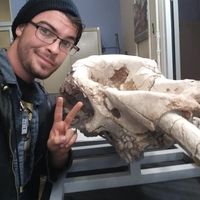Fantastic 13th Century Medieval Discovery Found Under Berlin
Archaeologists working with construction crews in the heart of Berlin have made an astonishing discovery. An immaculately preserved snapshot of a bygone era. An almost inconceivable discovery that help us paint a clearer picture of what life was like in medieval Berlin.
The crews were working in Stralauer Strasse, near a monument in one of the oldest parts of the city. They discovered a perfectly preserved 12th-century medieval plank embankment that once supported a dam structure. This dam structure protected one of Berlin's first roads helping to make the budding city more livable. Constructed out of the same oak trees lining the city today, the road helped to aid the first citizens of Berlin on their daily journeys. Archaeologists were able to attribute a date to the construction, 1238 AD. They obtained this data by utilizing dendrochronology, otherwise known as the study of tree rings. This method is extremely accurate. The city is giving guided tours of the excavation site so if you are in the region I would give it a look.
While modest compared to today’s freeways and railways, roads like this one helped make early medieval cities drier, healthier, and cleaner thus helping to reduce disease and general filth. These archaeological features represent an important record of early civil engineering in the 12th century. The timber plank embankments were constructed with oak logs laid out one after the other and preserved by a thick layer of clay creating an anaerobic environment. That clay no doubt consisted of some part of the filth of the day and helped to seal off the planks from oxygen levels that would normally cause the wood to rot.
These roads helped to fuel growth in Berlin and solidify its prominence in the region. Much has changed since this road was constructed, I doubt the first residents of the city would recognize today’s modern metropolis. It is inspiring to see how much human culture and built environment has developed since the 12th century.
It is rare to make discoveries like this for several reasons. Some of which include the depositional environment itself. Think about the difference between how thick clays and sandy soils might affect wooden artifacts. Often, archaeological features can be affected by previous development, agriculture, wartime activities, or simply decay. Important pieces and structures from antiquity have been destroyed in European cities like Berlin and Rome during the world wars of the 20th century.
City development also takes a toll on urban archaeological sites. As cities grow, what’s underneath is typically affected. That is why it is important to have archaeologists on call. To address development sustainably, governments all over the world have developed scientific methods to study construction projects. Construction monitors mitigate the effects that development has on the collective cultural heritage of a certain era. This discovery highlights the importance of that role.
One of the most exciting parts of the 21st century will be seeing the fruits of more countries adopting historical preservation laws. There are many more discoveries coming in the near future. Let us congratulate the archaeologists at The State Monument’s Office for their fantastic addition to the archaeological record.
Sources, Berlin Morganpist, The Archaeologist, The State Monument’s Office, University of Arizona Tree Laboratory of Tree Ring Research, Permaculture News








